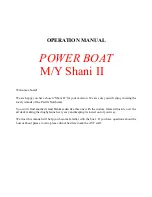
PAGE 11
SAILING
This manual is not intended to be a sailing instruction
manual and it is presumed that all owners will have a
basic sailing knowledge and skill. There are however,
many aspects of sailing a Corsair trimaran efficiently
and the following covers some of these:
THE BASICS
The mainsail is usually hoisted first. Turn directly into
the wind and commence pulling on the halyard. The
Pulse 600 has a roller furling boom fitted. Release the
handle from the locking socket on the mast allowing
the handle to roll freely. The main will automatically
unroll from the boom however if the halyard tension
becomes too tight unrolling a few turns in advance will
help ease the load.
Once the main is fully hoisted, attach the Cunningham
and pull tension until the majority of wrinkles have been
removed from the luff. The topping lift can now be
eased.
The mainsheet should now be moved from the furling
dogbone at the end of the mast to the mainsheet strop.
At this stage you should also attach the mast rotation
control to the boom and pull tight until the mast section
is pointing into the direction of the apparent wind. All
these controls are connected using snap shackles or
quick fitting hooks and are very easy to attach when
setting up.
All Corsair models sail and tack easily under mainsail
alone. If you have lot of tacking to clear a channel then
it may be much easier with just the main. You don’t
have to worry about tacking the jib and this won’t allow
you to go too fast particularly in crowded waters or if
there is minimal visibility.
The correct technique for sailing mainsail only is to
sheet it free to avoid choking the boat. The traveler
can be locked on the centerline and the mainsheet
slackened off so
the boom is about 12” out from center. Your boat
speed should be 7 - 8 knots in 10 to 15 knots of wind.
If you find boat speed is less, then the problem is an
over-sheeted main or trying to point too high.
There is a technique involved in sailing main only, and
once learned how, it is a very relaxed form of sailing.
The secret is to keep the main eased out more,
particularly after a tack. Don’t try to point high until
boat speed has built up.
You can now release the jib furler line and pull on the
leeward jib sheet. Now you’re sailing!
Corsair trimarans are sailed like any other yacht, the
most notable differences being the response, lightness
of the helm and the low angle of heel. This ranges from
an average of 5° to 10° to a maximum of about 15°.
Pointing ability is excellent but care must be taken not
to over sheet or try to point too high. Just a few less
degrees pointing, with sheets slackened slightly, can
see the boat speed jump from 10 or 12 knots to 12 or
14 knots.
To reef, first point the boat into the wind depowering
the main. Disconnect the cunningham eye tackle. The
topping lift should also now be used to lift the back of
the boom a couple of inches above horizontal.
Now release the outhaul from the clew, separating
the mainsail from the boom entirely. Go forward and
after releasing the main halyard pull the luff of the main
down untill the Cunningham can be hooked into the
reef attachment. Now lock off the main halyard. Go to
the back of the boom and reattach the outhaul to the
new reef position. The sail is now fitted in it’s reefing
position. The excess sail can be roiled up by hand and
then zipped away in the foot of the sail which has been
designed to house this extra sail while reefing. You
can now apply Cunningham and outhaul tension as
needed. Reefing is complete.
https://www.boat-manuals.com/










































